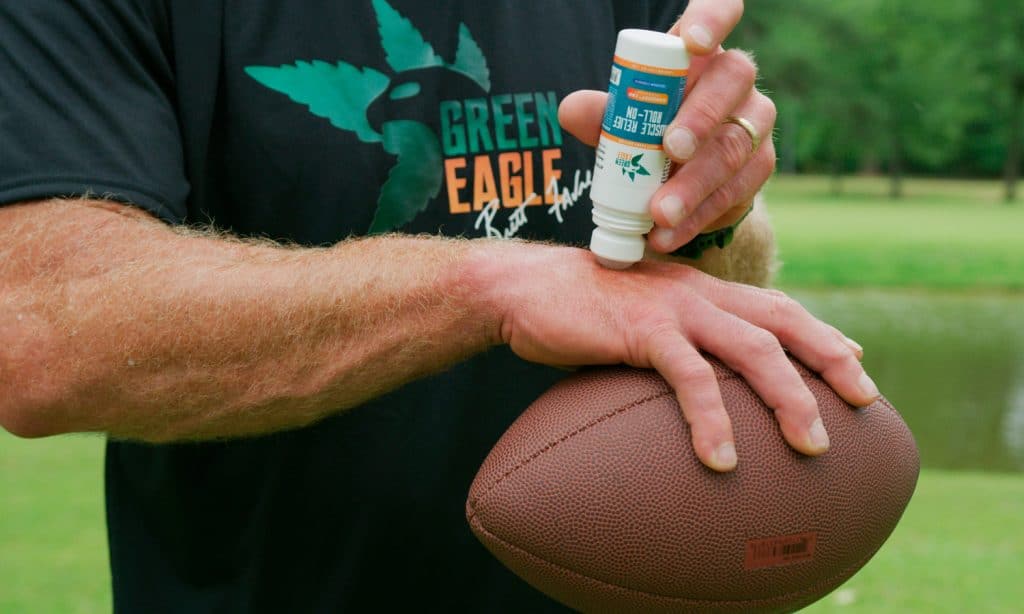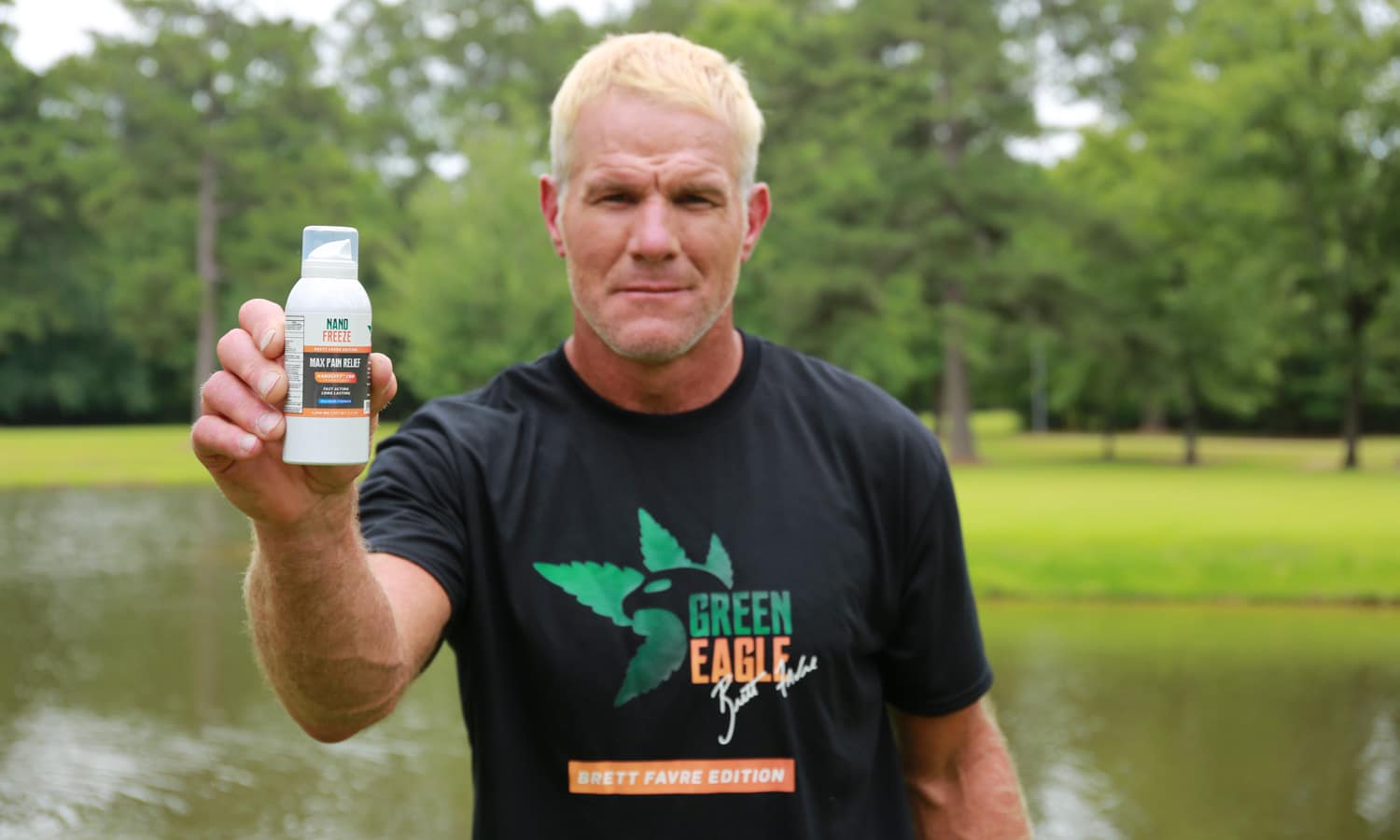The Gunslinger shares a personal story that’s all too familiar in the NFL: A football warrior overcoming pain with addictive substances only to face a tougher battle off the field than on it.
Brett Favre knows about pain. More than most rational humans, he knows about physical pain. The injuries he accumulated throughout his football career should astound you: torn bicep, broken thumb, concussions, elbow tendonitis, bone spurs in his ankles, severe sprains in multiple limbs, to name a few. In 1995, Pittsburgh Steeler defenders hit him so hard, Favre rushed to the sideline and coughed up blood. He returned the next play, threw a touchdown, and the Green Bay Packers won the game. In a fresh chapter, here is how Brett Favre went from Vicodin addict to CBD advocate.
Sportswriters and announcers couldn’t resist mythologizing him for all that pain. Gutsy, tough, The Gunslinger, as he was called. But Favre also knows how addiction can feed on that type of pain. He battled addictions to alcohol and painkillers while at the peak of his career as a quarterback. At his worst, he downed 15 Vicodin ES pills per night, asking teammates for their subscription allotments to feed his needs. That landed him in rehab for 75 days before the 1996 football season. “I actually got out like two, three days before the start of training camp and we ended up winning the Super Bowl,” Favre told me. “And I’ve never taken a pain pill since.”
Like former athletes before him, Favre has turned to cannabidiol, or CBD, to alleviate lingering pain from pro-sports. He still experiences tendonitis in his throwing elbow and is more active than a typical 50-year-old, biking 120-140 miles a week and training for half-marathons. Initially apprehensive to try CBD, he’s since become the brand ambassador for Green Eagle, which crafts a number of hemp-infused relief creams, roll-on sticks, salves, and other products. When Green Eagle CEO and founder Joseph Smadja met Favre about joining the company, the former quarterback agreed on some conditions — he first wanted to educate people what CBD was and he wanted to share his story.
RELATED: Is Marijuana The Next Recovery Revolution For Pro Athletes?
The first time Brett Favre took Vicodin was in 1992. Green Bay was playing the Philadelphia Eagles in Milwaukee County Stadium, back when the Packers played a couple home games there each year. It was Favre’s seventh start as a quarterback. In the first quarter, he faked a handoff and threw a simple wheel route to teammate Harry Sidney as the pocket collapsed around him. The consequence of that pass was the worst a quarterback could suffer in the 1990s — corporal punishment from Eagles defensive end Reggie White.
White, nicknamed The Minister of Defense and considered the all-time best defensive end by some, walloped Favre’s left shoulder into the ground with all his weight and all of Favre’s weight. White, for context, weighed over 300 pounds. After the play, the announcers thought Favre had injured his ribs the way he held his arm against his stomach. They were wrong. Favre had suffered a third-degree shoulder separation. “Third-degree separation, just to give people an idea, is the worst,” said Favre. “It only goes up to three.”
Favre received a Toradol injection with a numbing agent at halftime. Perhaps the strongest non-steroidal anti-inflammatory available on the market, Toradol was specifically designed to relieve post-operative pain. Studies have compared its effects to morphine and the drug feels like a wave of armor crashing over you, former offensive lineman and cannabis advocate Eben Britton once told me. But NFL teams have abused the drug for decades to keep players on the field, with players often forming a “T Train” before games to receive their Toradol shots, according to former tackle Eugene Monroe.

Toradol kept Favre on the field that day. He led the Packers to a dramatic 27-24 victory with CBS announcer James Brown saying “hats off, great courage” about the first of those heroic performances for which Favre would become known. But the Toradol wore off when Favre and the Packers rode the bus back home. Without the numbing agent, all the pain returned. Favre, despite his gauntlet of withstanding injuries, rates it among the worst pain he felt in his career. “So of course they gave me pain pills,” he said.
Taking those pills felt euphoric. That’s the word he uses — “euphoric.” Favre loved the sensation coursing through his body, even with his shoulder wrapped up and limp by his side. “[My shoulder] felt like when you squeeze a bag of popcorn,” he said. “You could feel stuff crackling and swishing around — but it didn’t hurt. That was the beginning of the end of my addiction process.”
RELATED: The Future of Marijuana Testing In College Sports
Most pain pills knock people out cold. Vicodin produced the opposite effect for Favre. He fell asleep naturally before 10 p.m. usually but now he transformed into a night owl. He could simply get more stuff done and loved it. Study opposing defenses more, work around the house, you name it.
He would pop one Vicodin per night, then he developed a tolerance, so he swallowed two pills per night. Then four. Then 10. Then eventually 15 Vicodin. Favre thought he had it under control. His secret was safe and hidden. But everyone around him knew what was going on. “You know, at 21, 22, 23, 25 you’re mischievous,” he said. “You almost think you’re getting away with something rather than what is this doing to me and where am I going? Where is it leading?”
“I was in a way over my head taking 15 a night,” he adds. “If I took that right now, I’d probably die. And you as well.”
Favre ultimately entered rehab three times — once for binge drinking and twice primarily for pills. He started 297 consecutive NFL games, a streak never to be broken, and the closest he came to taking pain medication was Motrin or aspirin. It’s the gutsiest act of his storied career.
He doesn’t pitch CBD as a cure-all godsend, as you sometimes hear it marketed. Limitations exist to its therapeutic value, he said, like when someone has a torn ACL or third-degree shoulder separation. He would know. But for the aches and pains every NFL players endures, it works. Rob Gronkowski, Ricky Williams, Monroe, Britton and other former athletes have all endorsed the benefits of CBD.
The latest Collective Bargaining Agreement (CBA) between owners and players didn’t permit current players using cannabinoids to relieve pain and inflammation. “CBD is a promising compound, but the extent of its use in the United States outpaces the level of evidence,” stated a white paper from a pain management committee formed between the NFL and its Players Union. But the latest CBA saw the league drastically loosen its cannabis policies. Players can no longer be suspended for positive marijuana tests, and will only receive tests for the drug during the first two weeks in training camp. Previously, random testing occurred between April and August.
Favre can’t give you an exact answer about the NFL’s resistance to CBD, but compares it to “kind of like convincing your parents that something nowadays is cool,” he said. “No one wears socks up to their knees anymore, Dad. We wear footies…you know what I’m saying?”
RELATED: Why The NFL’s New Marijuana Policy Isn’t A Total Win For Players
To be fair, Favre resisted CBD because he confused it with regular cannabis, fearing it would get him high. He’s since educated himself and believes there’s “a lot of upside with this plant, certainly from a healing standpoint.” Now he wants to educate those who aren’t sure what benefits CBD holds or those who won’t take anything they fear will cause them addiction. Because he understands their fears and wishes someone had given him alternatives like CBD, which he calls “safe,” as an NFL quarterback. He would go back now and tell himself that if he could.
“What I would’ve told my younger and more confident self is to be very, very cautious with anything that has the potential to cause addiction,” said Favre. “Try the alternative methods first. There are alternatives, obviously CBD being one of them, that are not going to give you an addiction or increase your addiction. And I think it really works.”


